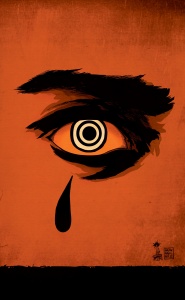The perpetual futz up comes face to face with a villain who is truly futzed up.

Written by Matt Fraction
Illustrated by Franceso FrancavillaThe most acclaimed new book of the year continues! Who pulled the trigger? Where have you seen him before? Have you seen him before? Maybe. But not like this. It’s murder, mayhem, and greasepaint make-up for the money, kids — and that means playtime is over, Monsieur Hulot. Caw caw.
“Hawkeye” #10 proves that the series has an incredible range. “Hawkeye” is normally peppered with humor and entertainment, this issue stands out as a dark chapter. The introduction of the new villain Kazi, the clown from Hell, is haunting and wonderfully successful. The creative team has positioned themselves on the razor’s edge between tragedy and comedy, and are able to keep their balance throughout the book. Francavilla’s uniquely beautiful art pairs with Fraction’s deft characterization to create an issue that is unlike the series has offered thus far.
While the subject matter and tone of this issue are more horror than romantic comedy, the signature “Hawkeye” sensibilities still come through. This is due to the fact that while focusing on Kazi, a very different character from Clint or Kate, Fraction exhibits the same level of dedication to showcasing personal motivation that he has used to make us fall in love with these heroes. We are invited to learn how Kazi became the man he is today; the story is so enthralling that his insanity seems almost logical. The sensitivity and sincerity with which he is written make it possible to feel sympathy for a monster.
In the same way that the tone of the has shifted in this issue, so to has the art. Francavilla’s work is darker and more chaotic than the art that Aja usually provides for the series. If Aja is Roy Lichtenstein, Francavilla is Francis Bacon. The aesthetic changes work to the book’s advantage, because they mirror Kazi’s internal state and reinforce the idea that we as readers should consider his perspective. The saturated colors used in this issue extend to the edge of the page, there are none of the clean white borders we usually see. While the series often features subjective tones of color, the choices here deviate from realism to an even greater degree. The layouts are organic, and add another layer of storytelling to renderings that were already highly narrative. Using elements from the story to separate pages into panels turns up the volume of the story. In this way the way the creators show us things becomes as important as the things they show us. In the first page of the story of Kazi’s early life, a fire rages. On this page embers and ash serve as panel insets, making this moment thematically and visually strong.
Visual cues help establish contrast between current events and Kazi’s memories. Slick, clean cool colors and polished perspective define modern New York City; while the flashbacks are colored with warm tones, and seem organic and fragmented. The contrast between the two settings is similar to the contrast between Clint and Kazi. Clint is shown unkempt and bandaged, wearing the same t-shirt he always wears, which has to need laundering by now. He needs to shave, and seems disheveled. When Kazi appears out of costume he is the personification of understated elegance and careful poise. His face is a flat field of color, suggesting an otherworldly perfection. The suit he wears is stylish and pristine, there is not a hair out of place. In costume, he retains a peculiar grace even while doing unthinkable things. The differences between Clint and Kazi go beyond their appearances. While Clint chooses the role he plays, and wants to be a hero; Kazi has continually been a victim of circumstance. The obstacles Kazi have been unavoidable external events, while Clint is his own worst enemy. By creating a foe that is so opposite of the hero, both characters traits are magnified. The contrast somehow makes both men seem more human.
Clint has no idea how to handle his relationships with women, while Kazi seems to know exactly what to say. In the scene in which Kate and Kazi interact, Fraction builds an incredible amount of tension. Their flirtation is frightening because even against the background of the terrible things that have happened to Kazi and the terrible things he has done, its possible to understand her attraction to him. He is magnetic, charismatic, and charming. There is a vampiric quality to the way he begins to seduce her. Throughout this exchange she remains the Kate we have come to know, an average girl with a quick wit. Seeing her caught up in his spell makes us believe we could be, too.
Throughout this series, it has seemed that Clint might be a hipster hero, doing his job almost ironically. In this issue; however, the irony is almost completely dramatic. We know what the boogeyman is up to, while the characters continue to go about their normal lives. “Hawkeye” has always refused to take itself seriously, but issue #10 proves that the tone of the book can stand up to more serious and sinister story lines. Creating a threat that seems not only eminent, but utterly real brings a new sense of gravity to the title. The exploration of this new villain is a testament to the range of this series.
Final Verdict: 9.2 – I’m telling you bro, this is quality stuff.



